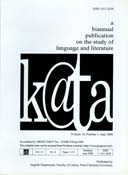Semiotics for Interpreting Quilt’s Cultural Values from the U.S. and Indonesia
DOI:
https://doi.org/10.9744/kata.20.1.18-26Keywords:
Transnational, American Studies, cultural values, quilt, semiotics, U.S., IndonesiaAbstract
Historically, quilt making has been recorded in the United States (U.S.) since the 18th century not only for its function but for the social expression of its people to their environment. The different colors and symbols used in designing and making quilts give knowledge to what quilt creators want to express. By use of library research and semiotics for an analytical-descriptive discussion, the socio-cultural and historical perspectives of U.S. quilts are found to explain how designs have evolved from the 18th to the 21st century of the U.S. The semiotics method has also shown how through an American Studies transnational process of cross bordering countries, the U.S. quilt has influenced its neighboring countries, like Indonesia. This article shares how a number of U.S. quilt patterns, colors and cultural values are found in Indonesian quilt. Among the cultural values found are the maintenance of loyalty and obedience. Interestingly, while the U.S. cultural value of individualism is respected, the Indonesian collectivism is preferred more in quilt making.
Downloads
References
Barthes, R. (1977). Images, Music, Text. Great Britain: Fontana Press.
Berger, A. A. (2000). Tanda-tanda dalam Kebudayaan Kontemporer. (D. Maryanto, & Sunarto, Trans.) Yogyakarta: Tiara Wacana.
Bost, M.I. (2010). Quilts as Visual Texts. Dissertations, Theses and Capstone Projects. Paper 418. Retrieved from http://digitalcommons.kennesaw.edu/etd.
Curtin, B. (2017, December 9). Semiotics and Visual Representation. Retrieved from www.arch.chula.ac.th/journal/files/article/lJjpgMx2iiSun103202.pdf
De Beauvoir, S. (1952). The Second Sex. New York: Knopf.
Elsley, J. H. (1990, June 15). The Semiotics of Quilting: Discourse of the Marginalized. Retrieved from http://hdl.hancle.net/10150/565534
Furnish, D. M. (2009). The Quilt as Concept. A Thesis, Deparment of Fine Arts, Graduate School, University of Louisville, Kentucky. Retrieved from https://ir.library.louisville.edu/cgi/viewcontent.cgi?article=1471&context=etd
Handayani, T. (2009). Makna simbolik quilt tradisional masyarakat Amish di Lancaster Country, Pennsylvania. Yogyakarta: unpublished Master tesis.
Kingelsmith, S. (1980, July 1). Women in the Mennonite Church, 1900-1930. The Mennonite Quarterly Review, 54, 163.
Paradisa, A. (2009). The languange of African American quilt patterns on underground railroad slaves movement in 1850s. Gadjah Mada University. Unpublished Master Thesis.
Proshina, Z., & Ustinova, I. (2012). English and Asian Flavor in Russian Advertising of the Far East. (N. Honna, Ed.) Asian Englsihes, 5 (2), pp. 30-59.
Smith, K. E. (2017, July 10). Framing Quilts/ Framing Culture: Women's Work and the Politics of Display. Retrieved from http://ir.uiowa.edu/etd/1083
Solomon, J. (1988). The Signs of Our Time. Semiotics: The HIdden Messages of Environments, Objects and Cultural Images. USA: St. Martin's Press.
Stewart, E. C., & Bennet, M. J. (1991). American Cultural Patterns: A Cross-Cultural Perspective (rev ed.). USA: Intercultural Press, Ltd.
Underground Railroad Quilt Blocks. (2017, April 2). Retrieved from Pinterest: https://www.pinterest.com/sageiger/underground-railroad-quilt-blocks/
Williamson, J. (1992). Decoding Advertisements, Ideology and Meaning in Advertising. Great Britain: Itjen Printers, Ltd.
Downloads
Published
How to Cite
Issue
Section
License
![]() This work is licensed under a Creative Commons Attribution License
This work is licensed under a Creative Commons Attribution License



.png)
.png)

















